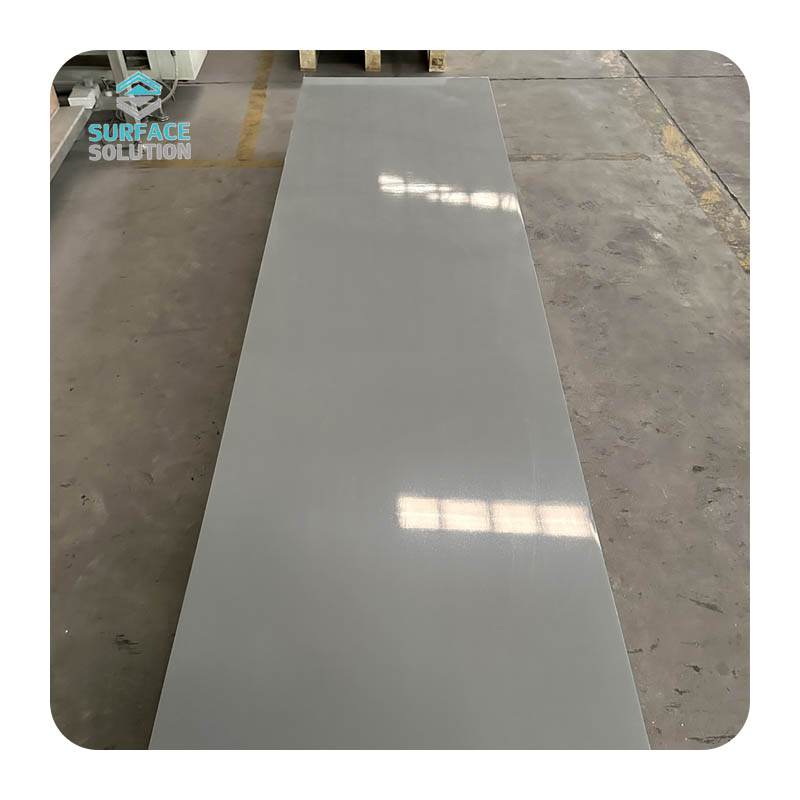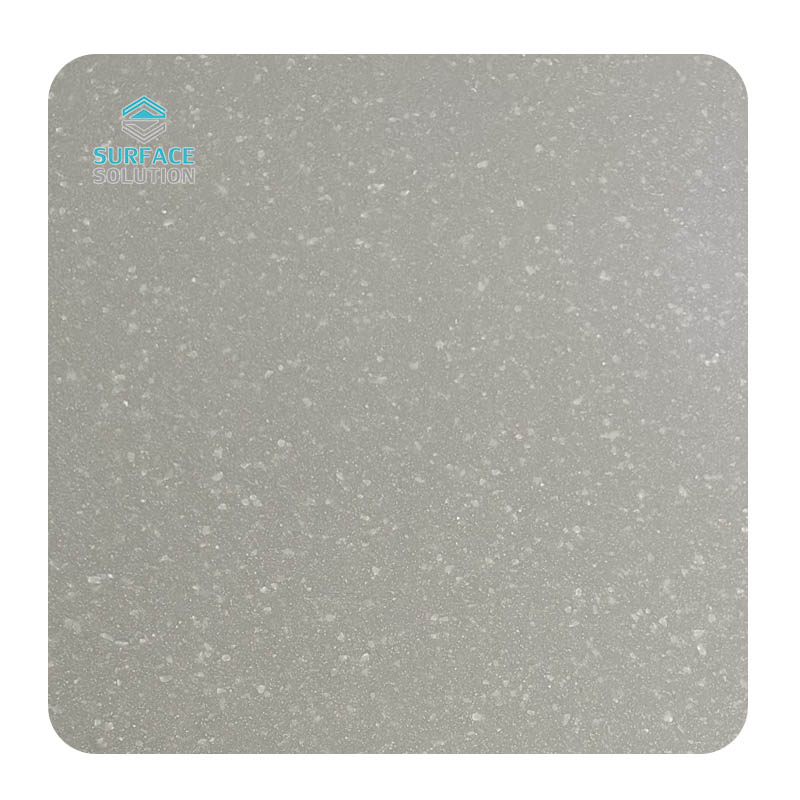

First developed in the 1960s by DuPont to fix natural stone’s porosity and early synthetics’ fragility, today it’s made by brands like Surface Solution, Staron and Swanstone—all retaining core characteristics with slight formula variations.

Resin Base: The binding element, either acrylic resin (most common, made with non-toxic methyl methacrylate) or polyester resin (more affordable but less impact/heat-resistant). Acrylic resists stains and chemicals better.
Filler Material: Fine, inert powders like aluminum trihydrate (from bauxite, adds fire resistance by releasing water vapor when heated) or ground marble/quartz dust. This boosts strength and creates a smooth finish.
Pigments & Additives: Small amounts of pigment create hues from neutrals to bold tones (even “marble-look” patterns). Some formulas add UV resistance (for outdoors) or antimicrobial properties (for kitchens/bathrooms).
Seamless Installation: Special color-matched adhesives join sheets without visible gaps. This creates a sleek look and eliminates hygiene hotspots (no crevices for food or mold)—ideal for kitchens.
Moldable & Customizable: Unlike rigid natural stone, it’s thermoformable. It can be shaped into curved edges, rounded corners, or integrated features (built-in sinks, soap dishes), fitting any style from modern to traditional.
Stain & Chemical Resistance: Acrylic-based options resist coffee, wine, or oil stains. Unlike porous natural stone (which needs sealing), spills wipe away with mild soap. Avoid harsh chemicals like bleach.
Repairability: Minor scratches buff out with fine sandpaper; deep chips fill with matching resin. This extends lifespan to 20+ years with care.
Smooth, Non-Porous Surface: It’s easy to clean (no sealing) and prevents mold—perfect for bathroom vanities. It’s also gentle on dishes, unlike abrasive granite.
Acrylic-Based: 70% of sales (e.g., Surface Solution, Staron). Durable, impact-resistant, and less likely to fade. Available in solid colors or subtle speckles.
Polyester-Based: Budget-friendly (e.g., some Swanstone models). Used commercially or for cost-saving. Bold patterns but prone to scratches and sun fading.
Composite: Blended acrylic-polyester resins balance affordability and performance. Some include recycled fillers for eco-friendliness.

Kitchens: Seamless design and stain resistance work near sinks/stovetops. It integrates with under-mount or “integrated sinks” (same material as the countertop).
Bathrooms: Moisture and mold resistance suit vanities and shower surrounds. Custom shapes fit modern designs like floating vanities.
Other Spaces: It works for home bars, laundry countertops, outdoor kitchens (UV-resistant formulas), and furniture (tabletops).
Integrated Sinks: No gaps between sink and countertop, preventing water buildup.
Curved Edges: Soft edges add modern style and safety for kids.
Color Consistency: Unlike natural stone (varying veining), it has uniform color—great for a cohesive look.
A seamless, easy-to-clean surface.
Repairability (no full replacement for minor damage).
Customization (curved edges, integrated sinks).
A mid-range budget.
Related Blogs
-
 Space-Saving Solutions with Acrylic Solid Surface DesignsIn an era of shrinking living and working spaces—from micro-apartments in urban centers to compact café kitchens—designers and homeowners are increasingly prioritizing "space efficiency" without sacrificing style or functionality. Enter acryli
Space-Saving Solutions with Acrylic Solid Surface DesignsIn an era of shrinking living and working spaces—from micro-apartments in urban centers to compact café kitchens—designers and homeowners are increasingly prioritizing "space efficiency" without sacrificing style or functionality. Enter acryli -
 How to Find the Surface Area of a Solid: A Step-by-Step GuideThe surface area (SA) of a solid is the total area of all its outer faces or surfaces. Unlike volume (which measures space inside a solid), surface area focuses on the "outside"—a key measurement for real-world tasks like wrapping a gift (
How to Find the Surface Area of a Solid: A Step-by-Step GuideThe surface area (SA) of a solid is the total area of all its outer faces or surfaces. Unlike volume (which measures space inside a solid), surface area focuses on the "outside"—a key measurement for real-world tasks like wrapping a gift ( -
 What Are Solid Surface Countertops Made Of? A Deep Dive Into Their CompositionSolid surface countertops have become a staple in modern kitchens and bathrooms, celebrated for their seamless appearance, durability, and versatility. Unlike natural stone (such as granite or marble) or laminate, they are
What Are Solid Surface Countertops Made Of? A Deep Dive Into Their CompositionSolid surface countertops have become a staple in modern kitchens and bathrooms, celebrated for their seamless appearance, durability, and versatility. Unlike natural stone (such as granite or marble) or laminate, they are -
 What Are Solid Surface Countertops? A Complete OverviewIn kitchen and bathroom design, solid surface countertops stand out as a versatile choice, balancing functionality, aesthetics, and durability. Unlike natural stone (granite, marble) or synthetic quartz, they offer unique benefits—but what exact
What Are Solid Surface Countertops? A Complete OverviewIn kitchen and bathroom design, solid surface countertops stand out as a versatile choice, balancing functionality, aesthetics, and durability. Unlike natural stone (granite, marble) or synthetic quartz, they offer unique benefits—but what exact
















